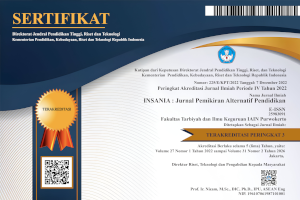Mengembangkan Format Penilaian Komprehensif dalam Pengembangan KTSP
DOI:
https://doi.org/10.24090/insania.v15i3.1555Abstrak
Abstract: Logical consequence enactment Permendiknas No. 22, 23, and 24 in 2006 and Government Regulation (PP), No. 19 in 2005 was the management curriculum is left entirely to each the education unit which includes covering the development, implemntation to the evaluation. In management, it is expected every Education Unit able to integrate the development, implementation and evaluation in accordance with the principles of valuation. In the field of development and implementation, in implicit regulation orders to accommodate either three domains of cognitive, effective, psychomotor which is comprehensive and continous. But on the other hand, policy evaluation and rating system specified is not relevant to the demands that were ordered. Therefore, this paper tries to describe the format of assesment in accordance with the principles of the development, implementation and assesment principles in the curriculum or the Education Unit as outlined in Permendiknas and the Government Regulation (PP). Keywords: Format, Evaluation, Curriculum, Development, Implementation, and Education.Unduhan
Unduhan
Diterbitkan
Cara Mengutip
Terbitan
Bagian
Lisensi
Authors who publish with this journal agree to the following terms:
Authors retain copyright and grant the journal right of first publication with the work simultaneously licensed under a Creative CommonsAttribution-ShareAlike License that allows others to share the work with an acknowledgment of the work's authorship and initial publication in this journal.
Authors are able to enter into separate, additional contractual arrangements for the non-exclusive distribution of the journal's published version of the work (e.g., post it to an institutional repository or publish it in a book), with an acknowledgment of its initial publication in this journal.
Authors are permitted and encouraged to post their work online (e.g., in institutional repositories or on their website) prior to and during the submission process, as it can lead to productive exchanges, as well as earlier and greater citation of published work (See The Effect of Open Access).








